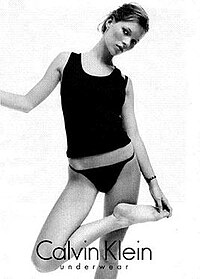https://www.exberliner.com/features/history/christiane-f-photo-series/
https://en.wikipedia.org/wiki/Heroin_chic
Heroin chic was a look popularized in early-1990s fashion and characterized by pale skin, dark circles underneath the eyes, a very skinny body, stringy hair, and an angular bone structure. American supermodel Gia Carangi is remembered for being the originator of the look.[1][2] Characterised by emaciated features and androgyny, it was a reaction against the "healthy" and vibrant look of models such as Cindy Crawford, Elle Macpherson, and Claudia Schiffer. A 1996 article in the Los Angeles Times stated that the fashion industry at the time had "a nihilistic vision of beauty" that was reflective of drug addiction.[3]

Background
At the time during which heroin chic emerged, the popular image of heroin was changing for several reasons. The price of heroin had decreased, and its purity had increased dramatically.[4] In the 1980s, the AIDS epidemic had made injecting heroin with unclean needles increasingly risky.[4] Available heroin had become more pure, and snorting became a more common mode of heroin use.[4] These changes decreased the stigma surrounding the drug, allowing heroin to find a new market among the middle-class and the wealthy, in contrast to its previous base of the poor and marginalized.[4] Gia Carangi, who some call the "first supermodel"[2] is remembered for being the origin of the heroin chic trend.[1] Heroin infiltrated pop culture through attention brought to addictions in the early 1990s. In film, the heroin chic trend in fashion coincided with a string of films throughout the 1990s—such as The Basketball Diaries, Singles, Trainspotting, Kids, Permanent Midnight, and Pulp Fiction—that examined heroin use and drug culture.[5]
Grunge
In the early 1990s, the rise of the grunge alternative rock music and subculture in Seattle brought media attention to the use of heroin by prominent grunge artists. In the 1990s, the media focused on the use of heroin by musicians in the Seattle grunge scene, with a 1992 New York Times article listing the city's "three principal drugs" as "espresso, beer and heroin" [6] and a 1996 article calling Seattle's grunge scene the "...subculture that has most strongly embraced heroin".[7] Tim Jonze from The Guardian states that "...heroin had blighted the [grunge] scene ever since its inception in the mid-80s" and he argues that the "...involvement of heroin mirrors the self-hating, nihilistic aspect to the music"; in addition to the heroin deaths, Jonze points out that Stone Temple Pilots' Scott Weiland, as well as Courtney Love, Mark Lanegan and Evan Dando "...all had their run-ins with the drug, but lived to tell the tale."[8] A 2014 book stated that whereas in the 1980s, people used the "stimulant" cocaine to socialize and "...celebrate good times", in the 1990s grunge scene, the "depressant" heroin was used to "retreat" into a "cocoon" and be "...sheltered from a harsh and unforgiving world which offered...few prospects for...change or hope."[9]
Leading grunge band Alice in Chains had a song "God Smack", which included the line "stick your arm for some real fun", a reference to injecting heroin.[7] Seattle grunge musicians known to use heroin included Kurt Cobain, who was using the drug very frequently around the time of his death.; "Andrew Wood of Mother Love Bone overdosed on heroin in 1990"; "Stefanie Sargent of 7 Year Bitch who died of an overdose of the same opiate in 1992, along with Layne Staley of Alice in Chains who publicly detailed his battles with heroin...".[10] Mike Starr of Alice in Chains[9] and Jonathan Melvoin from The Smashing Pumpkins also died from heroin. After Cobain's death, his "...widow, singer Courtney Love, characterized Seattle as a drug mecca, where heroin is easier to get than in San Francisco or Los Angeles."[10]
Rise and fall
This waifish, emaciated look was the basis of the 1993 advertising campaign of Calvin Klein for his perfume Obsession featuring Kate Moss. Film director and actor Vincent Gallo contributed to the development of the image through his Calvin Klein fashion shoots.[11][12]
The trend eventually faded, in part due to the drug-related death of prominent fashion photographer Davide Sorrenti in 1997.[13] In 1999 Vogue dubbed Brazilian supermodel Gisele Bündchen "The Return of the Sexy Model" and the beginning of a new era.[14]
Criticism and analysis
Heroin chic fashion drew much criticism and scorn, especially from anti-drug groups.[15] Fashion designers, models such as Kate Moss and Jaime King, and movies such as Trainspotting were blamed for glamorizing heroin use. Then-U.S. president Bill Clinton condemned the look.[16] Other commentators denied that fashion images made drug use itself more attractive. "There is no reason to expect that people attracted to the look promoted by Calvin Klein and other advertisers... will also be attracted to heroin, any more than suburban teen-agers who wear baggy pants and backward caps will end up shooting people from moving cars", wrote Jacob Sullum in Reason magazine.[13]
In popular culture
In the Season Nine Seinfeld episode "The Voice", Jerry asks Elaine about her "somewhat de-poofed" hair, to which Elaine quips, "It's the new look. You know, heroin chic?"[17]
Keine Kommentare:
Kommentar veröffentlichen